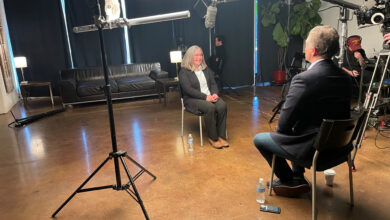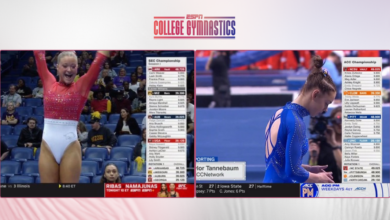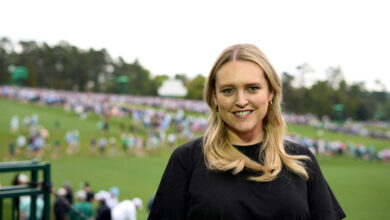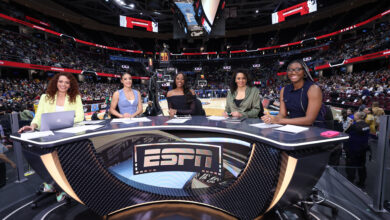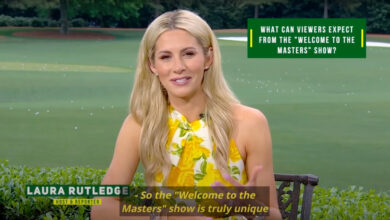Visions of 2020, As Seen by Two Dozen ESPN Journalists
See, Feel and Relive What 24 ESPN Journalists Learned About Their Craft in 2020
Jen Karson,
E60 Producer
During this unprecedented time, I think the thing I learned most about journalism is that you can always find a way to tell important stories, no matter the obstacles, the distractions, or the lack of resources. We have an even greater responsibility now, more than ever, to tell those stories, to showcase people’s grit and determination through the toughest of times, and to provide that needed inspiration during a chapter of all of our lives that we certainly won’t forget.
For me, personally, it meant producing and directing with my newborn daughter, Payton, by my side … literally. They say “start ‘em young,” and that is certainly what has occurred while working from home.
Marc J. Spears,
Senior NBA Reporter, The Undefeated
What I learned about journalism in 2020 is creativity and technology can turn back on the stadium lights even in the darkest times. After the COVID-19 pandemic caused sports to be shut down worldwide, suddenly, I was doing interviews with NBA stars on Zoom to get my job done. I spent 90 days in the NBA Bubble at Walt Disney World writing about the resumption of the season with a passed COVID-19 test needed daily. And I did live television shots from my hotel room on my iPhone. The challenge isn’t over, but we have learned to survive.
Says Andrea: “Making do in my sister-in-law’s old bedroom in Michigan – for a TV hit with Packer & Durham as the ACC debated whether to continue its season – while on ‘vacation,’ visiting family.”
Andrea Adelson, Reporter
Believe it or not, 2020 ended up being my most productive year yet as a journalist. It sounds counterintuitive since I did not take one single reporting trip after March 10. But I found that in this year, perhaps more than any other, people wanted to talk. When I made a phone call or sent a text, I got more than a reply. I got a real connection. I got heartfelt emotions; I got heartfelt answers; I got hope and fear and frustration and uncertainty. I felt empowered in ways that surprised me, even though my only means of communication was a phone line or virtual meeting.
That made me a better journalist and storyteller, and for that, I will always be grateful.
Luis Aldea, Producer
With 2020 coming to a close, I think it’s important to take a step back and look at how we’ve made it not only “just work” but kept delivering an outstanding product that’s expected of the ESPN brand.
It’s been a challenge, but a welcome one. I’ve gone from giving my son a bath to conducting interviews on Zoom with a camera crew present on-location.
What I’ll always take away from this year, more than any other is to check on people; How are you? How’s the family? I’ve learned more from my coworkers in these last nine months than in the last nine years and I’m proud to call them my friends.
Says Tory: “My mask was only off for the picture!” during this June trail hike in Malibu.
Tory Barron, ESPN.com Editor
Stop me if you’ve heard this before: These are unprecedented times. The innocuous phrase became a staple of our daily rhetoric back in March, and never quite seemed to get the hint that we were over it. That we had dealt with more than enough news of the unprecedented nature, and instead longed for the familiar, predictable and safe. While the sports world was far from immune to the chaotic nature of 2020, journalism persevered.
In my case, that meant writing a newsletter. The ESPN Daily Newsletter kept showing up in your inbox (assuming you subscribe, if you don’t – that’s on you) five days a week. I might not have stepped foot outside of my apartment for three days or changed out of my groutfit (grey sweat outfit) in as long, but I always wrote the newsletter.
For me, the newsletter was a respite from the severity and the isolating nature of the year. A place where we could opine that the NFC East best resembled a dumpster fire, or celebrate when “The Last Dance” gifted us the visual of Dennis Rodman wearing a leather jacket, sipping a beer and riding into the night on a motorcycle. A place where we could laugh through our shared pain. To borrow a line from Voltaire (yeah I quote Voltaire, what of it?): “Life is a shipwreck, but we must not forget to sing in the lifeboats.”
Malika Andrews,
NBA Reporter
It is commonplace for sports to be the little sibling, the toy department, the frivolous dessert of a newsroom that covers everything from global affairs to politics. This year in journalism, sports was oftentimes the main course — particularly around coronavirus coverage. When I think back to March 11 when the NBA shut down, it was a large domino falling and alerting Americans to take the virus more seriously.
My colleagues at ESPN were on the frontlines of that coverage, helping our readers and viewers to understand why sports were being shut down, but also working to explain what this virus is and conducting interviews with experts about its effects. Some of the most consequential and pressing issues in our country and the world this year were racism and coronavirus, and at times the intersection of the two. Sports stood firmly in the middle of it all and the sports journalists at ESPN were right there in the middle of it, documenting, informing, asking hard questions and holding power to account.
Jeff Passan,
MLB Insider
I don’t get nervous going on TV anymore, but
March 12 terrified me.
The sports world was shutting down, and a virus of unknown provenance was proliferating throughout the country, and I had to put this completely foreign moment into context where none existed. Over the next nine months, our job at ESPN — our duty — was to do just that. To take this epoch, which was scary to some and confusing to others and frustrating to everyone, and make sense of where sports fit.
Fan-free stadiums, abundant positive tests and manifold cancellations later, it’s clear: at the forefront of American society, where it always has. Not even a pandemic can stop sports.
Jeff Passan with ESPN Senior Writer Buster Olney and MLB.com’s Mike Petriello, March 12.
Kelley Carter, Senior Entertainment Reporter/Host “Another Act,” The Undefeated
One thing I learned in 2020 is to appreciate life and my work more. Sounds simple. But like so many families, I have lost beloved family members due to COVID-19 that I have not fully mourned yet. I lost them in the midst of truly finding so much joy in seeing my career spin in a completely different, but successful direction. Some days were amazing, as I was able to bathe in the excitement of my work. Other days were unbearably sad dealing with loss, and the jarring images of racial injustice in America. The only thing that would uplift me is the very thing that I imagine was uplifting others who were consuming the content we produced: the idea that we provided some respite from the overbearing realities in 2020.
Says Lauren: “The ‘new’ war room. I traded the multiple-TV live publishing space for a TV on the deck this year for college football, and while I couldn’t watch as many games at once, I did love getting to work outside!”
Lauren Reynolds, ESPN.comExecutive Editor
In 2020 I learned that while we journalists pride ourselves on asking our subjects hard questions, we haven’t asked them often enough of ourselves – of our hiring practices, of the way we support our diverse employees, of how we’re caring for our team’s mental health. Putting that spotlight on ourselves led to hard, necessary conversations. We’re nowhere near perfect, but I believe we’ll emerge from this year a far stronger, smarter and curious team – and that will be reflected in the work we do each day.
Tesfaye Negussie, Digital Producer
After COVID-19 shuttered us in our homes, I wasn’t travelling, as usual, to produce videos for The Undefeated. Then, in May, after a string of unarmed Black citizens were killed by police, George Floyd lost his life. The streets of Washington D.C. were ignited with protestors. I learned that I didn’t need to travel across the country to tell meaningful stories. I focused on my own communities and neighborhoods to document demonstrations by citizens of all cultures, ethnicities and socio-economic backgrounds who were fed up with injustices happening in their country.
Ramona Shelburne, ESPN.com Senior Writer
Like so many parents, one of my biggest challenges has been juggling my job with taking care of my 2-year old son, Daniel. But when those work calls inevitably came during my childcare times, I found people were very understanding because so many were going through the same thing! In a way, I felt like the social distance and isolation that causes was actually a bonding experience for everyone this year. Because if there’s one thing we’ve all learned in 2020, we’re all in this together.
Chris Connelly,Reporter / Essayist
Well, I learned that clamping my iPad onto a tripod was the best way to Zoom. I learned that reporting and writing something long and detailed from the past, in which my subjects faced crises and withstood them, helped to fend off bouts of discouragement brought on by [gestures to the rest of the world].
I hope I learned to honor the significance of stories shared for the first time in the wake of the Black Lives Matter movement. . . like the ones from then-Dodgers coach George Lombard and his siblings, talking about their late mother Posy Lombard and her life as a civil rights activist. And I learned how to set up my own live shot at home so that I looked O.K.
. . . most of the time. Not always.
Brooke Pryor,NFL Nation Pittsburgh Steelers Reporter
In a year where nothing felt normal, I found comfort not just in reading stories of good works, but in writing them, too. My favorite stories are the ones the off-the-field that humanize people we elevate and deify for their athletic abilities. When I felt helpless to the circumstances of the pandemic, sharing stories of Pittsburgh Steelers helping out the community, like hiring local artist Cody Sabol for more custom works than usual to keep his family afloat when the pandemic decimated his income, gave me hope and comfort — and I found so much joy in passing that on to sports fans also in search of hope and comfort.
Michelle Beisner-Buck, NFL Features Reporter
It’s 2:17 p.m. CT, Saturday, Dec. 19, 2020. The crew I’ve spent the entire season with, Second Wind Creative, and I just wrapped seven interviews from my basement, in two-and-a-half days. Under “normal” circumstances, it would’ve been tough to pull this off. For instance, we interviewed Steelers defensive tackle Cam Heyward from Pittsburgh, and an hour later, interviewed Hall of Fame cornerback Rod Woodson, from Las Vegas. This is the bright side of storytelling in a pandemic. Thank you, Zoom. Thank you, ESPN.
I miss being in the same room, connecting with the person I’m interviewing, but that doesn’t mean human connection is lost.
Storytelling in 2020 may have looked different, but the intent and execution has remained heartfelt and inspiring. I’ll always be a storyteller, because no matter the circumstances, there is a story to be told. Bring it on 2021, we are ready!!!
Says Jen: “Getting outside for family walks was a welcomed part of our routine during distanced-learning and working from home in 2020.” Pictured: Jen’s husband, Dario; children, Chase, Layla, Keira; and dogs Wrigley, Max
Jen Lada, Reporter
I have been blown away by our group’s ingenuity and creative approach to storytelling this year. And while I certainly understand the restrictions on travel and in-person interaction, the reality is some conversations suffocate when conducted virtually.
We routinely ask people to defy human nature – which is to guard and protect oneself from pain – and instead ask them to recall, relay and relive some of their most difficult experiences in excruciating detail. I’ve come to really appreciate the importance of being in the room, physically sharing that space and energy and actively empathizing with our subjects.
We’ve done an incredible job of bridging the gap and making the best of challenging circumstances. But this year has made it impossible not to recognize and appreciate the bond that occurs when you sit across from someone sharing their story with us and the world.
Paula Lavigne, Reporter
One of the last assignments I traveled for was a criminal court hearing in February in New York. Our legal system, just like everything else, needed to figure out how to adapt when COVID-19 forced many of us to stay at home.
My reporting colleagues and I were party this summer to a civil public records case in Florida. We attended the hearings from all over the country via Zoom. If you ever struggled with Zoom disruptions, imagine being a district court judge trying to rule on a case while your condo association insists on repeatedly testing its fire alarm.
Blake and his wife, Kate, quarantining and working remotely in Colorado.
Blake Foeman, E60 Associate Producer
2020 has been the year of innovation, sacrifice and profound patience. From producing entire stories via Zoom from the comfort of your own couch, to spending countless hours uploading and downloading footage with spotty Wi-Fi. There was never a dull moment, and the adversity taught us to be more creative, communicative and appreciative. When I look back on all of the stories we told this year, I will always remember that no matter how difficult the obstacles were, we all knew to get the job done by any means necessary!
Lisa Salters, MNF, NBA and E60 Reporter
What I learned about journalism in 2020 is what I was taught back in school years ago — that you don’t need much to tell a good story. The pretty pictures, lighting, and creative camera angles are all nice — but at the end of the day, all you really need is a compelling story. And 2020 gave us plenty of those. This unique year affected us all in different ways — that included the players and coaches I got to talk to every week. Being able to share their struggles and successes this year — and every year — continues to be my privilege.
Andrea Pelkey,
SC Producer
Here’s 2020 in a nutshell: Relationships matter. COVID forced us to adapt and adjust without experiences to draw upon. We found ways to thrive in sports journalism without physically being in the space with athletes.
Relationships we’ve worked to build and sustain throughout our careers were reignited and flourished the last 10 months. The sports world is small. And we got closer this year. The way you interact with people matters long term. The need to manage fears of the unknown but utilize that vulnerability in our storytelling became paramount once we got back into the field.
We were able to bring sports to fans from a place they truly could not go and experience themselves.
Says Andrea: “Patriots reporter Mike Reiss and I have been a team for 10 years. We have a tradition before kickoff of every game we give each other a fist bump. The tradition carried on – through plexiglass.”
Myron Medcalf,
ESPN Staff Writer
In 2020, the pandemic forced us to focus on the fundamental elements of journalism: storytelling. Whether through Zoom, masked in-person interviews or phone calls, the conversations I’ve had in recent months have reminded me that, more than anything, we are here to highlight the human experience through the prism of sports. I learned that, no matter the circumstances, our responsibility will never change. People need to be heard and a year like this magnified the value of those perspectives and how fortunate we are to have these roles. This year, I learned that the stories still matter most. And they always will.
Says Myron: “This has been my favorite getaway in the pandemic: Bridge over the St. Croix River in Minnesota.”
Seth Wickersham, Senior Writer
After the people and the platform, the thing I love most about working at ESPN is the travel. If you need to go somewhere, you are on a plane in short order. And then, with the world, it stopped.
You can do excellent journalism over the phone – our team raised the bar in 2020 – and I got used to it. But one summer day, our family dined in the infield of the local ballpark. I love stadiums — for a semester I was an architecture major — and it felt comforting to be back in one. I played catch with my kids, and after they left for ice cream, I stayed behind. I walked around vacant centerfield, hearing the echo of the sights and sounds of a life I swore to myself I would never take for granted but at times probably did.
It was a lesson that we got into this business not for the phone, but for the people and places — to see, smell, hear, touch, live. You can work your way around it — we all did this year — but there’s nothing like the sight of sitting across from a person and the sound of a live voice.
Michele Steele, Reporter
At the beginning of the NFL season, the expectation was we might not have any access to players outside of official team-sanctioned Zoom sessions with the rest of the media. Before this [early October] game in Chicago, I emailed the Colts PR director – who I’ve worked with many times in the past – and floated the idea of doing a safe, socially-distanced post-game interview with one of the players-of-the-game. And that’s how we were able to speak with cornerback Jalen Collins, whose fourth-quarter interception helped seal a 19-11 win for Indianapolis. Thinking outside the box is how we will keep getting content for viewers they can’t get elsewhere. Here’s to a happy and healthier 2021!
Says Cristina: “My kitchen table, where I’ve spent my days editing, Zooming, etc. And I’ve never seen a byline like [the one for this story], and I’m so proud of the work.”
Cristina Daglas, Senior Deputy Editor
We’re used to being out in the field, talking to sources, working together. And in an instant this year, that was gone. But with access altered and storylines rapidly evolving, something else emerged – deep collaboration. Out of both want and necessity, reporters and editors worked together more closely than ever. From news-breaking to deeply reported narratives, bylines ballooned. There were Zoom brainstorms and text chains, there were massive projects and tick-tocks with reporter contributions from bubbles and kitchen tables. It was a wonderful outcome amid chaos, and something I hope we’ll maintain.
Aladdin Freeman, Director
One day we are going to reflect on our work at the [TopRank] bubble [in Las Vegas] and realize it was one of the most exciting, challenging and rewarding moments in our careers. Those of us that were fortunate to do it from the beginning to the end will truly never forget how blessed we were to be part of this project.
Nick Pietruszkiewicz, ESPN.com Senior Editor, Golf
This was a year in which we saw and heard (or didn’t see and didn’t hear) like never before. Empty stadiums. Silent golf courses. Faces behind masks. But what I take away most from this dreadful year was the purpose and creativity of journalists who still found ways to tell their stories. Can’t be at event? Jump on a Zoom call. Can’t do a face-to-face, one-on-one interview? Send a text or a DM. They found a way to get the job done, to serve audiences.
And when the doors opened again, when we were allowed to see things in person with our own eyes and hear them with our own ears, things certainly looked different. (Masked and socially-distanced) I walked back to the media center at Northern Trust in late-August after watching Tiger Woods and Rory McIlroy spray shots all over TPC Boston and, wouldn’t you know, there they were, just like the rest of us might, sitting down at picnic table having a burger and a Diet Coke. It was both normal and abnormal and all so 2020.
Design by Rich Arden
